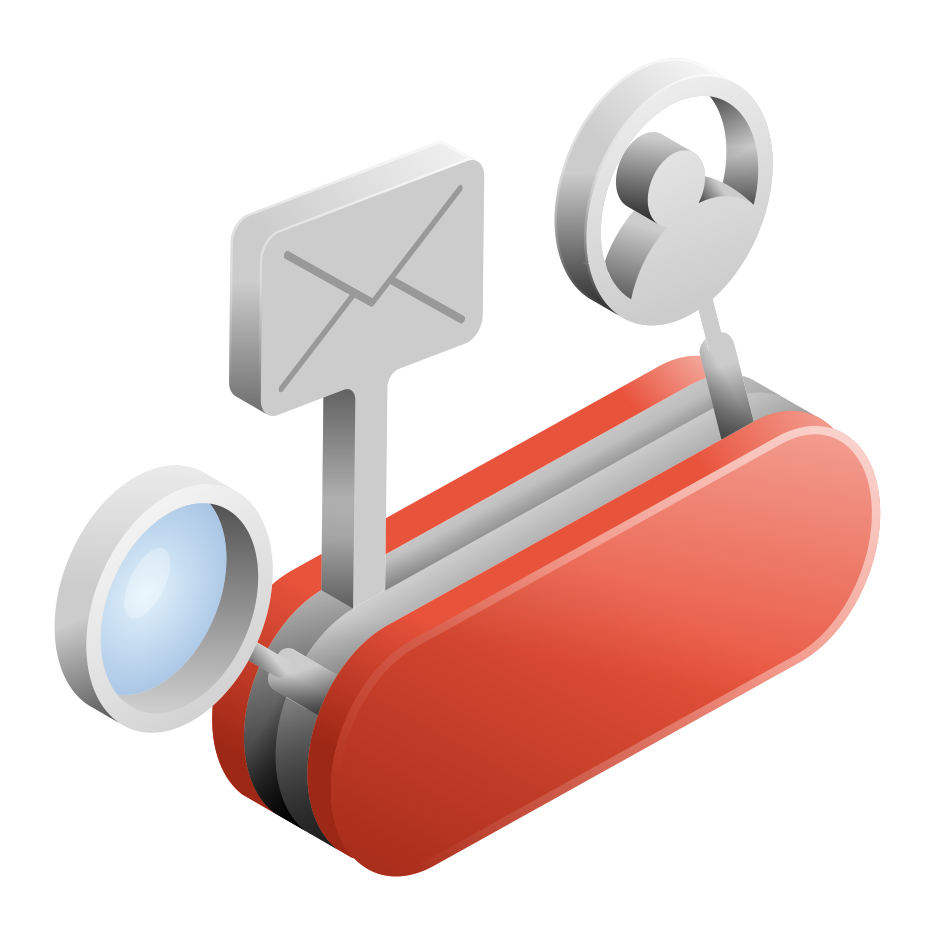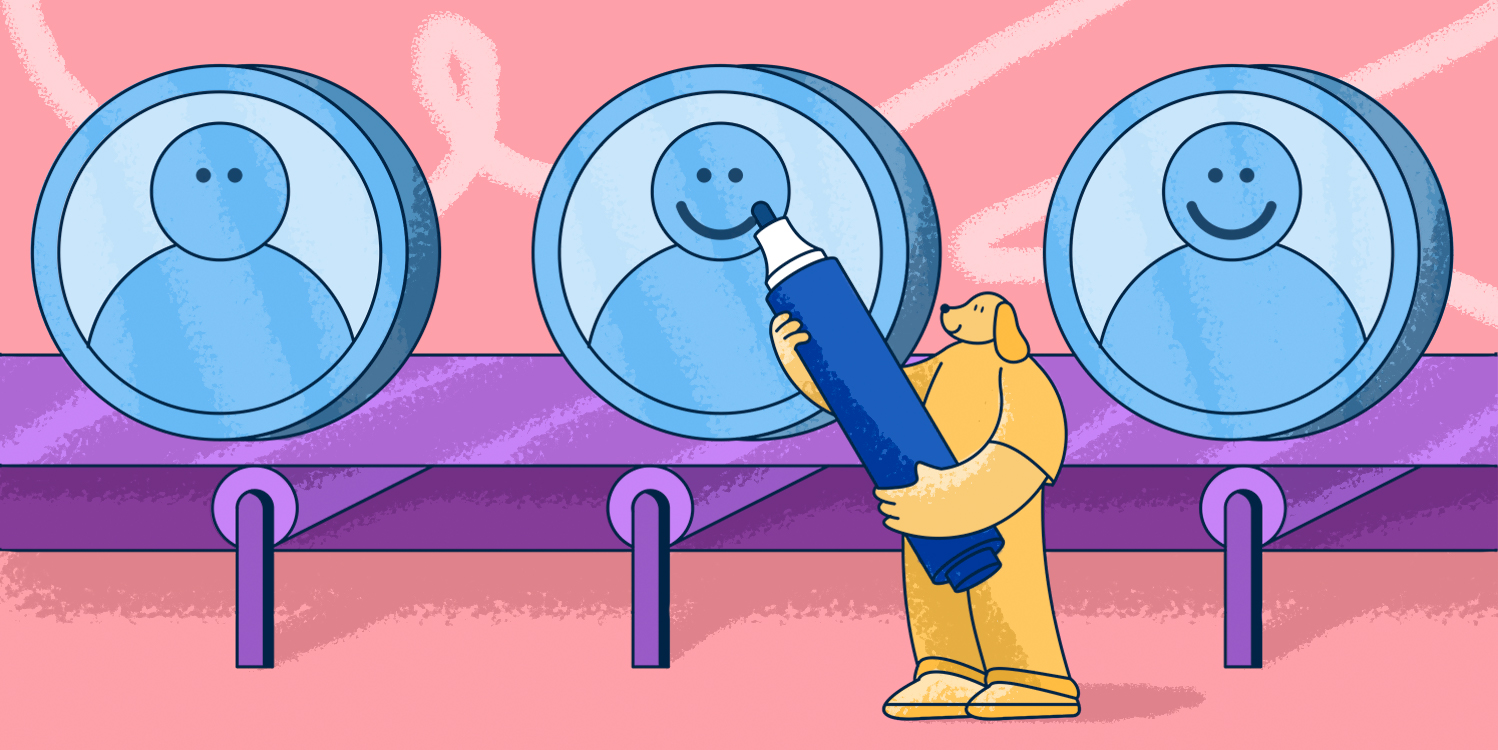How wrong are those companies that think impeccable product or service is enough for customers to start recommending their brand here and there?
While some clients will promote you, there will also be those who, for some reason, remain silent… until you encourage them to put in a good word for you.
The truth is, however, that only 11% of sales professionals ask for referrals.
In this blog post, we’ll tell you why referral marketing is a necessary part of doing business and share some actionable ways of asking for referrals from your customers. But let’s start with the basics first.
Outline:
What is referral marketing?
A referral is the act of a customer recommending a product or service to other people, either by word of mouth, via social media channels, on special platforms, etc.
As mentioned above, not all referrals happen organically. Your business can and actually should implement specific techniques to encourage your customers to refer your company to people they know — that’s what referral marketing is.
Why is referral marketing important?
Companies with referral programs in their arsenal run their sales processes much more efficiently than businesses without referrals.
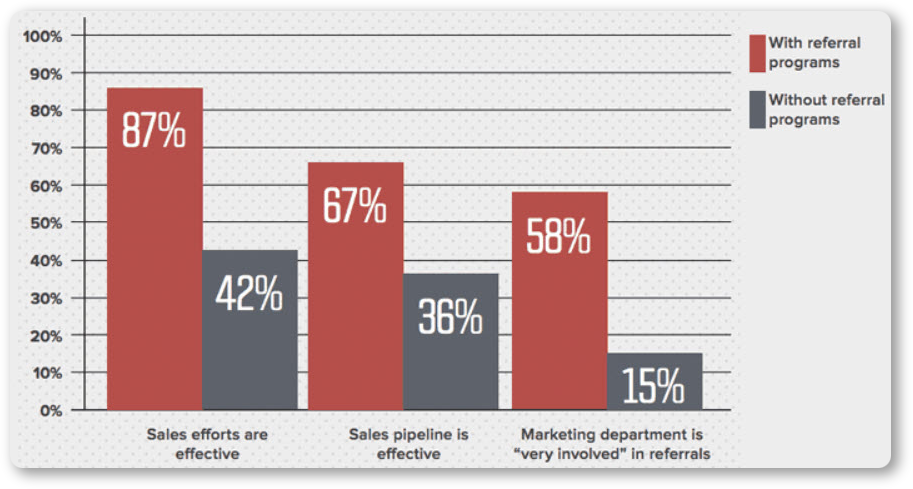
The reasons for such efficiency are not difficult to guess if you look at the figures below.
Referrals enhance decision-making
About 84% of B2B decision-makers start the buying process with a referral since B2B customers are more inclined to trust peer recommendations than pitches from the company’s sales and marketing teams.
Referrals bring you more quality leads
Referrals provide valuable leads as these people are already nurtured through peer recommendation. As a result, referred customers are easier to convert, and upon conversion, they have a 16% higher lifetime value.
Referrals increase customer retention rates
Apart from higher lifetime value, customers whom your business got through referrals are more likely to repeat their purchase, increasing your customer retention rate by 37%.
Referrals generate more revenue
Another benefit of acquiring customers through referrals is that referred customers spend 200% more than the average customer. Therefore, the cost of incentivizing referrals is much lower compared to the revenue you’ll generate after converting these customers.
Referrals increase brand awareness
Even if your loyal customers aren’t able to convince their peers to buy from you this week or this month, you can be sure they will spread the word about your company, and many potential leads will learn about your business before you reach out to them with your cold email or cold call.
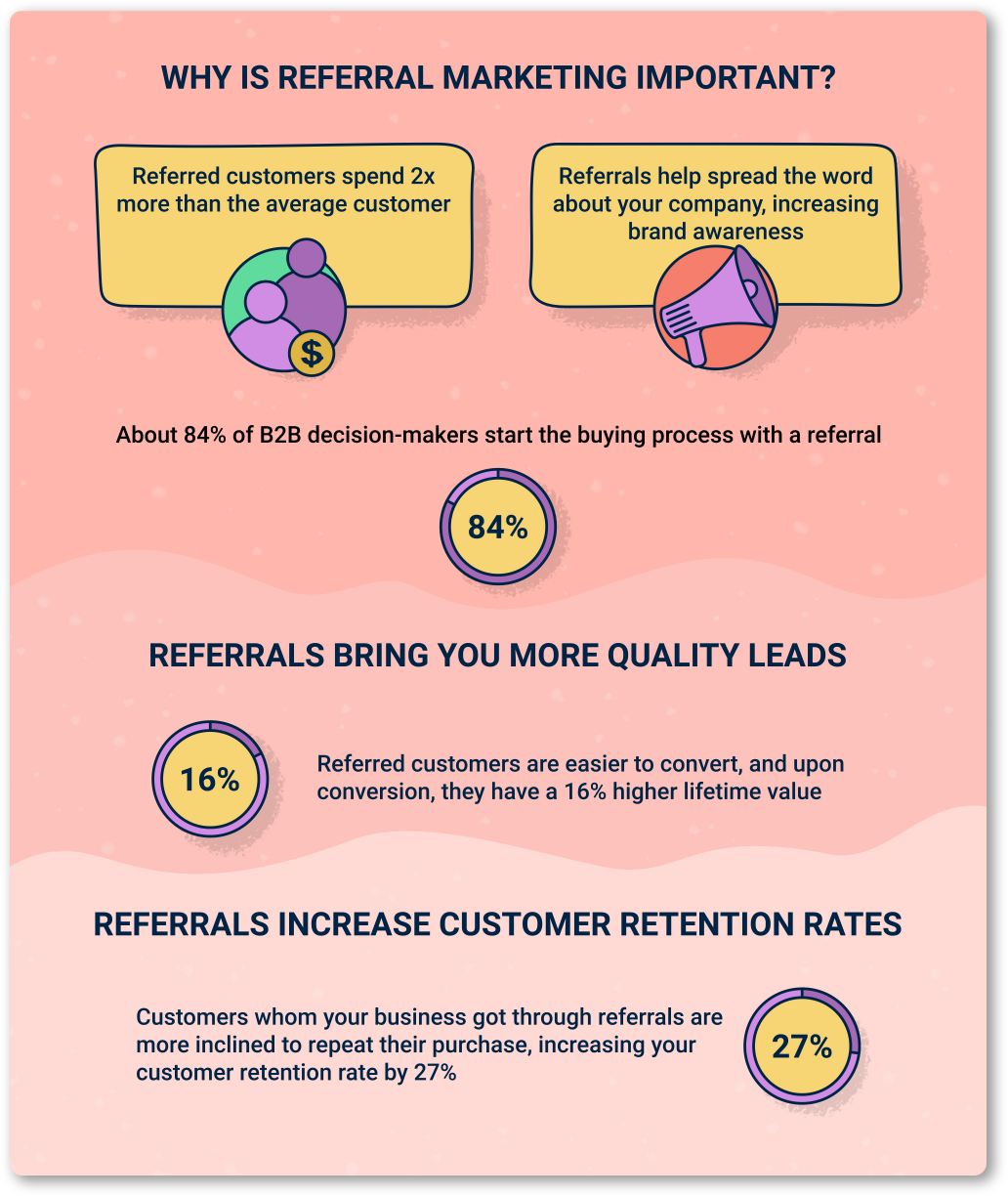
How to ask for referrals: 10 proven strategies
As you see, having a referral program is a venture worthy of your resources, let alone the pretty fact you won’t really need a lot of them. But what’s the best way to encourage your customers to recommend your company as the one others can do business with? We’ve prepared the 10 best working strategies for you.
1. Bring value first
Referrals rest on the customer’s satisfaction with a product or service. That is why I wouldn’t recommend that you ask for them immediately after closing a deal. You’ve positioned yourself as a company that brings value, remember? Continue providing it after closing a sale and let your clients feel it!
Say, if your customers have just purchased your service, offer them your immediate support or quality onboarding. Your company is about to release a new feature? Great, it’s time to inform your customers how they can benefit from it.
After your clients understand the real value of your product, they’ll be more prone to start telling their network about your business.
2. Identify your brand advocates
There are always those companies that are more satisfied with your product than others. So, one of your primary tasks is to identify the best of the best, i.e., your brand advocates.
To make this process easier, I advise you to use a simple Net Promoter Score (NPS) survey, which boils down to sending out a single question to your customers: “How likely are you to recommend our company/product/service to a friend or colleague?” Ask your respondents to score their answers based on a 1-10 scale.
Responses with a score of 9-10 should be considered by you as “Promoters” of your business. Don’t hesitate to reach out to them, asking them to vouch for your work or product!
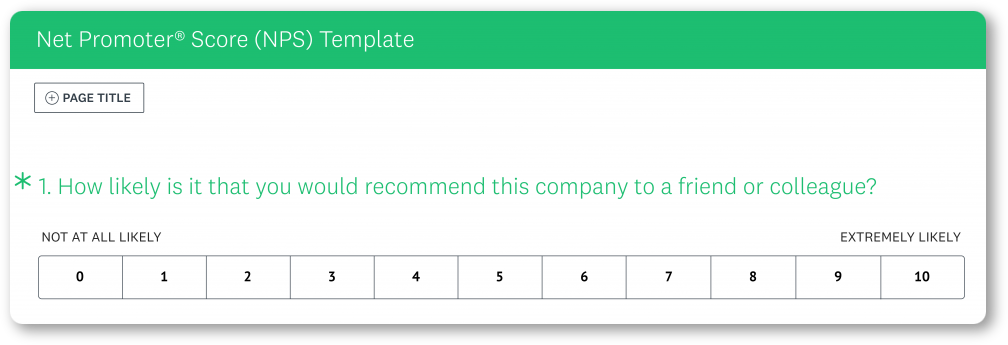
3. Further segment your customers
NPS helps you segment your customers, but you can go deeper. Apart from “Promoters,” you will identify customers who have scored 7-8 and are called “Passives.” Segment them into a separate category – these clients will become your potential referral participants a bit later, after you nurture them properly, e.g., with follow-ups, special offers, etc.
Another segment you can pick out is long-time customers. The fact they’ve been using your product or service for so long indicates their loyalty, which means they’re probably more than happy to spread the word about a brand they love.
I’m sure you can come up with other ideas for segmenting your customers based on how likely they are to recommend your company to their peers. Just please, never neglect segmentation. It will help you create a personalized approach to each group of your promoter customers, increasing your chances of getting word of mouth for your business.
4. Find the perfect time for requesting referrals
I don’t like this ‘perfect time’ expression as there can be no perfect time for outreach. Yet, you can always try to find the best moment for requesting referrals.
Let’s think about it from a psychological point of view. When do people look friendliest and most approaching? When they are happy, of course.
And what are the happiest moments for your customers? For example, when your customer support has just helped them solve an issue, after a successful transaction, or as soon as they’ve shared positive comments about your product somewhere on social media. Be attentive to what your customers say about you to catch them while they feel this air of satisfaction with your company.
5. Use customer feedback and testimonials as a springboard to referrals
To add to the previous point, concentrate on customers’ positive experiences with your product. Ask for their feedback or use cases that will serve as solid proof that your solution brings value.
As soon as your customers see how they’ve developed with your product or service and you wrap their experience up in a bright testimonial, the door to asking them for referrals will be opened.
Letting your customers understand their progress is a super-actionable psychological trick for getting them on your side, as from now on, your clients will associate their success with your business.
6. Be in constant contact with your clients
Make sure your referral request doesn’t come out of the blue. For this, you should get in touch with your customers with certain regularity. Show them you are always there for them so they never feel abandoned.
There are various ways to maintain regular contact with your customers for their referrals. For example, you can:
- Subscribe to their social media account so that you know about their recent updates and start a relevant conversation.
- Follow up on their blog updates so that you can email them about a recent or the most resonating post.
- Connect with them on LinkedIn to comment on their posts or congratulate them on their business achievements.
→ If you wan to start reaching out on LinkedIn, check our detailed guide on LinkedIn automation tools.
7. Be specific when asking
As soon as you’ve warmed up your customers to the point they’re ready to be your advocates, there’s no place for vague questions or hints. Be straightforward and ask for referrals directly. If you are a SaaS company, you can ask them something like, “Do you have any peer companies in mind looking for a software solution like we provide?”
8. Reward customers for their referrals
Let me just repeat it again: no matter how superb your product or service is, there will always be those customers who won’t rush into singing the praises of your company here and there.
Don’t get upset about it, and never give up – let these customers be just another segment in your list whom you’ll offer an incentive program.
Gift cards, a discount on next month’s plan, a bigger plan at the same price – there are many incentive options. Just promise you’ll send the first N customers a gift in return for their referral, and you’ll see the result in minutes – customers will hurry up to share good words about your company.
9. Start with yourself
There’s nothing better than a good example. If you want customers to recommend your brand, start with yourself: refer them passively, sharing their business with your network. Using this strategy will spark reciprocity, so your customers will be inclined to say something good about your company in return.
And even if it doesn’t happen immediately, regular work in this direction – whereby you’ll be sharing customers’ blog posts, leaving positive reviews, advertising their recent product launch on social media – sounds like a reason for requesting their referrals, doesn’t it?
10. Use various channels
Like any other form of outreach, asking for referrals has a golden rule: the more channels you use, the more fruitful your campaign will be. So now, let’s take a closer look at how you can ask for referrals on different channels.
How to ask for referrals on your website
Think about the pages of your website your customer visits after the purchase – it can be a knowledge base, blog, etc., – place a pop-up with a clear CTA message, something like “Love our service? Why not tell your friends about it?” and offer multiple options for a referral.
For example, you can ask your customers to share the emails of their peers who’ll most likely love your product. Alternatively, you can encourage your clients to say something about your company on social media.
Another option is to create a special referral program page that will explain how the program works and what benefits customers will get by joining it (HINT: incentives we’ve talked about above).
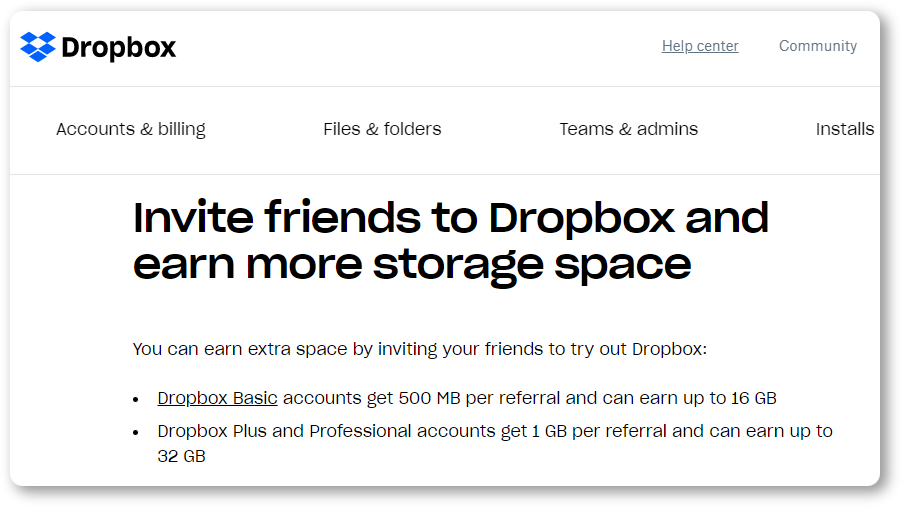
How to ask for referrals on social media
If you have a social media account on Facebook, Twitter, LinkedIn, or Instagram, don’t hesitate to use it for requesting referrals. You can direct it to a specific person or write a general public post. As for the latter, your message can vary from a straightforward “Tell a friend about us and get a $10 discount on the next month plan” to something more subtle, e.g., “Thank you for being our family. Let’s grow it even more.”
Take a look at how Jolt did it via their LinkedIn post:
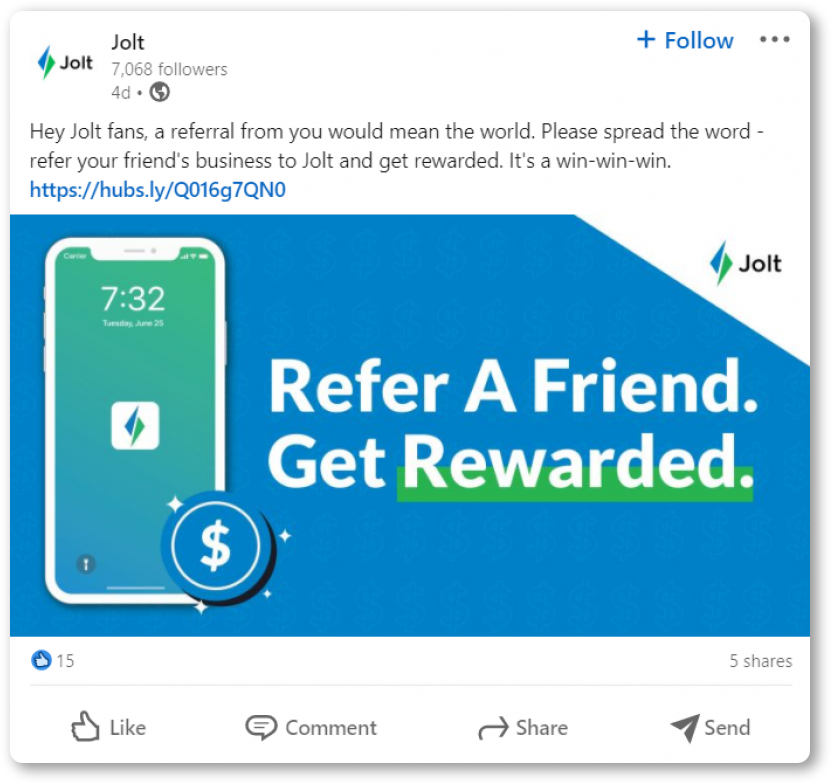
How to ask for referrals via email
Asking for referrals through email is one of the most effective ways to spread the word about your business. You can do it in one of your follow-up messages after your customers have made a purchase.
Referral emails shouldn’t be long. I mean, you don’t need to include all the details of your relations there. Believe me, customers who have had a positive experience with your business won’t need to be persuaded by long-reads. Just be specific, highly personalized, and friendly.
Here’s a great referral email example from Evernote:
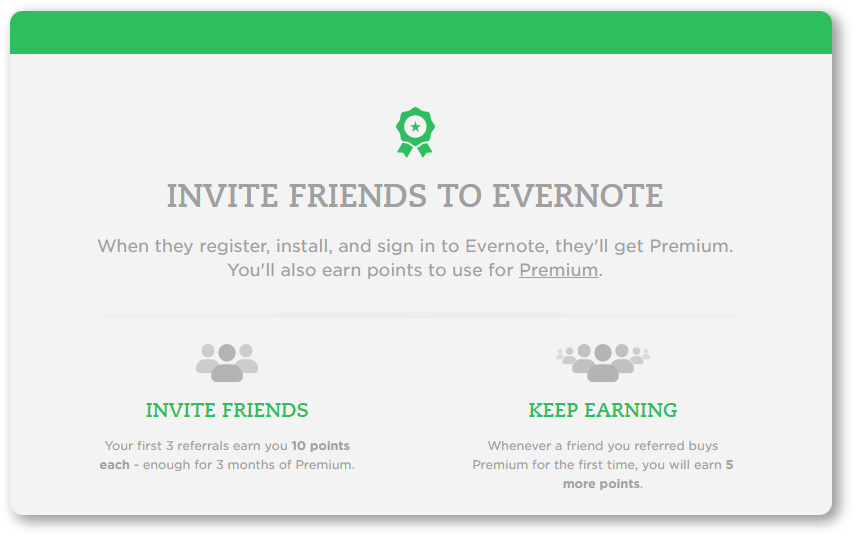
As email marketing is the easiest and most affordable way of reaching out to your customers with a referral request, I suggest we focus on it a little more and discuss how to write referral emails in a smart way.
How to write a referral email
Overall, when asking for referrals through emails, you need to stick to the same rules as when writing any other business letter. We’ve prepared small tips you can keep in mind while crafting your own referral email:
Think of a proper email structure
Write a catchy email subject line, add both addresses and a signature. In the email body, you can mention how fruitful your cooperation with the customer has been, provide an incentive, and crown your email with an enticing call to action.
Personalize your email
Remember I stressed the need to segment your customers? Now it’s high time you used segmentation. Personalize your referral email based on your interactions with customers and their behavior after the purchase. Besides, don’t forget to hook their attention with the specific information you know about them (their new product launches, achievements, business events, and whatnot).
Find a proper time for sending a referral email
There are many discussions among marketing and sales professionals about the right time for sending emails. According to studies we’ve done here at Snov.io, the best time for sending emails (from the point of high open and click rates) is on Tuesday and Friday, at 10-11 am.
But you know your customers better, so why not analyze the history of your email campaigns and find out the time when your customers were most active?
Use referral email templates for automation
As a business working at scale, you won’t be able to write a new referral email each time you want to ask for customer recommendations. That’s physically impossible. Therefore, I’d advise you to collect a bunch of referral email templates that will serve as a reliable skeleton for your personalized emails and help you automate your email referral outreach.
To help you with this task, we’ve prepared several referral email templates you can add to your collection and start using today.
Customer referral email templates
You can craft referral email templates for dozens of different cases. Here we’ll provide you with the most popular situations: when you deal with a new customer, when you request a referral from a loyal client, and when you wish to express gratitude to your customer for referring your company.
Template #1. How to ask for a referral from a new customer
|
Hi [Customer name], I’m so happy to see you’ve had such a great experience with our team. We’re putting everyday effort so that you stay satisfied with our service and feel confident about using its features. You can always contact our support team with any questions. In the meantime, do you know anyone else who also needs help with [Your customer’s pain point that made them choose your company]? Let me know, or feel free to share [Your company name] with them. Regards, [Your name] |
Template #2. How to ask for a referral from a loyal customer
|
Hi [Customer name], Thank you for your trust in our company! I’m delighted to hear you’re satisfied with the results of working with [Your company name] so far. What if together we could help any of your colleagues at similar companies benefit from [Your company product/service] and achieve similar growth? If you have any in mind, feel free to let me know or share [Your company name] with them. Regards, [Your name] |
Template #3. How to thank a customer for their referral
|
Dear [Customer name], Thank you for referring [Referee name] to [Your company]. I’m sure we will be as helpful to them as we’ve been to you. As a token of our appreciation, here’s a promo code for 10% off your next month plan from us. Thank you for your trust in [Your company name]. Kind regards, [Your name] |
Wrapping up
Customers may adore your product or service but still be reluctant to publicly praise your company. Don’t wait for them – ask for referrals yourself. Referral marketing is your best strategy to grow business, and there are so many ways of requesting referrals through various channels.
And if you need a solid platform to build your referral program, the one which will store all your interactions, help you set up LinkedIn automation, and take care of follow-ups, Snov.io is here for you – a Swiss knife for business outreach with an absolutely free CRM!


